Mexicans Celebrate Our Lady of Guadalupe with March From West Village to St. Patrick’s
The celebration started at midnight with a Mass at Our Lady of Guadalupe at St. Bernard parish on W. 14th St. before commencing a two mile procession up Eighth Ave. in the morning that ended at St. Patrick’s cathedral, on Dec. 12., marking the feast of the patron saint of Mexico and other Latin countries.
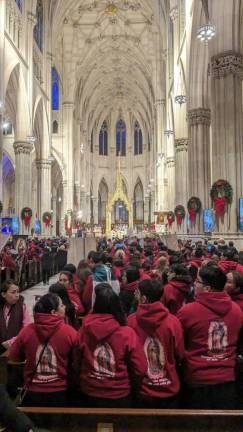
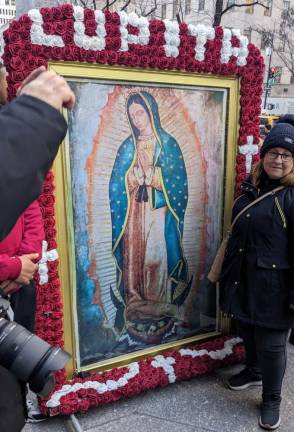
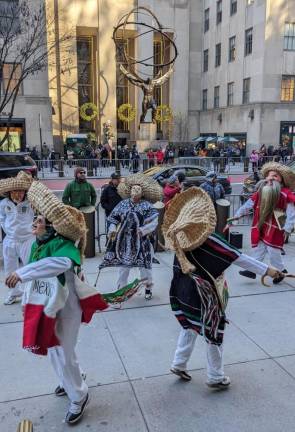
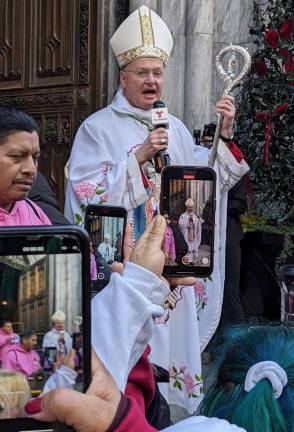
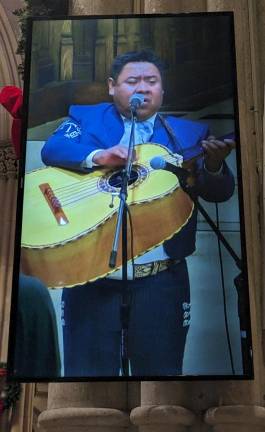
Thousands of Mexican New Yorkers and other Latinos took to the streets Dec. 12 in celebration of the feast of Our Lady of Guadalupe. Accompanied by a rolling NYPD enclosure, the procession began around 8:30 a.m. at its namesake parish, the Church of Our Lady of Guadalupe at St. Bernard on West 14th Street, ran north up 8th Ave, and turned east at West 50th Street, arriving at St. Patrick’s Cathedral before 10 AM.
For those unfamiliar with the story of Guadalupe—which is perhaps more widely known in the Hispanic southwest than in the city— it’s a fascinating tale dating back to early Spanish Mexico.
On December 9, 1531, Guadalupe—a Spanish incarnation of the Virgin Mary—was said to have appeared before a middle-aged Chicimeca Indian man named Juan Diego and, speaking in his native Nahuatl language, asked him to build her a shrine upon the Hill of Tepeyac, a suburb in today’s Mexico City. Diego, a Catholic convert whose indigenous name was Cuauhtlatoatzin—the talking Eagle—followed her request, and informed the Bishop of Mexico, Juan de Zumarrága, what must be done.
Skeptical, the Bishop asked Diego to provide a sign that his vision was true. Again, on December 12, Guadalupe appeared to Diego, and led him to place where roses where, even though it was winter, roses were blooming. Diego gathered up the flowers, wrapped them in his cloak and returned to the Bishop. When Diego opened his cloak, the roses fell to the ground, while upon the cloth of his cloak, there now appeared the colorful image of Guadalupe herself. Now that’s a sign!
In 1737, Guadalupe became the patron saint of Mexico City, and later, of all Mexico and parts of what today are California, Guatemala and El Salvador. Today, the large religious complex at Tepeyec, anchored by the Basilica of Our Lady of Guadalupe, is a hugely popular pilgrimage site, attracting millions of visitors each December alone. In 2002, Juan Diego was canonized by Pope John Paul II, becoming the first Indigenous person to be sainted in the Americas.
Remarkable as this is, Guadulupe transcends religion, and stands as an ubiquitous symbol of cultural pride, strength, and resistance. Here in New York, look closely and you’ll see Guadalupe statues nearly everywhere in establishments with a Spanish flavor in restaurants, groceries, bakeries, and other shops, and in Mexican-themed art in general.
Indeed, so ardent are the devotees of Guadalupe, that the celebrations of her feast day begin at the earliest possible moment, at midnight on December 12. Such was the case at the Church of Our Lady of Guadalupe at St. Bernard, which hosted a midnight mass, followed by other ceremonies, including the blessing of the symbolic Guadalupe torch, that continued through the dawn.
For those with a less nocturnal schedules, the procession from St. Bernard to St. Patrick’s and the rituals that unfolded there, were themselves inspiring.
The first thing one noticed were the costumed dancers, whirling and shouting to sharply rhythmic flute music on the 5th Avenue sidewalk, directly in front of the Cathedral’s steps and opposite the famed statue of the Greek titan Atlas at the entrance to Rockefeller Center.
Most of the dancers were dressed in white, karate-suit like pants and shirts, and wore giant straw sombreros with extravagant tail-like crowns, as well as colorful ponchos, belts, flags or bandanas. Bells affixed to their ankles and shakers in their hands added to the scene’s rhythmic vibrancy.
Some dancers also wore large, bearded masks, while other masks were clean shaven. One man dressed as a tiger cracked a leather whip on the ground, encouraging the dancers’ bounding gyrations.
As this was going on, the other celebrants watched and stood in a line stretching up 5th Avenue and around the corner of 51st Street in anticipation of entering the Cathedral. Consisting of a roughly equal number of women and men, most wore various colored hoodies, with pink, maroon and red especially popular.
Also conspicuous were many signs of devotion to Our Lady of Guadalupe, or “Lupita,” as she affectionately nicknamed, a fact attested to by the many people getting their pictures taken in front of a large, framed painting of her, wreathed in red and white roses spelling Lupita. One colorfully embroidered banner of Guadalupe read simply “Reina de Mexico”—Queen of Mexico.
After being welcomed in fluent Spanish by the multilingual Staten Island native, Bishop Edmund Whalen, everyone filed inside for mass.
For those more familiar with the traditions of Irish or Italian Catholics, it was a fascinating, and joyous, ceremony, with a live mariachi band, and frequent songs, including “Las Mañanitas,” a popular Mexican birthday tune with many variant lyrics.